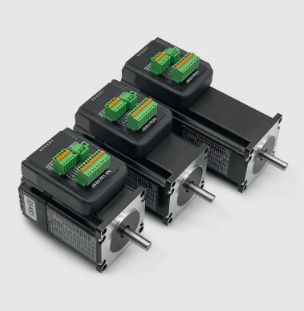Kärnkomponenter i en Servomotor
Motorförsamling: Kraftkällan
I kärnan av varje servomotor sitter motorns montering, som omvandlar el till faktisk rörelse. Den här delen gör verkligen hela konstruktionen funktionsduglig när det gäller att uppnå exakta rörelser. Det finns flera motoralternativ där ute, såsom AC- och DC-modeller, där varje typ är bättre lämpad för olika arbetsuppgifter. De flesta väljer AC-motorer när en jämn hastighet under drift behövs, medan DC-versioner tenderar att föredras där hastighet och vridmoment behöver justeras under rörelse. När man väljer en motor spelar effektivitetsvärden och hur mycket effekt den levererar stor roll, eftersom dessa faktorer påverkar både hur bra systemets prestanda är och hur mycket energi det förbrukar över tid. En titt på vissa verkliga data visar att finjustering av dessa aspekter inte bara gör att systemen håller längre, utan också ökar deras tillförlitlighet, något som fabriksskötare bryr sig mycket om inom tillverkningsindustrin.
Återkopplingsenhet: Noggrannhetskontrollkomponent
Återkopplingsenheter är avgörande för att behålla servomotorernas precision eftersom de ger realtidsinformation om motorns position, hur snabbt den roterar och vilken kraft den applicerar. Dessa enheter kopplar egentligen ihop det som styrsystemet önskar sker med det som faktiskt sker i motorn själv. De flesta fabriker använder antingen kodare eller resolverar för detta ändamål. Kodare är utmärkta när något behöver röra sig med stor precision, såsom i utrustning för halvledartillverkning. De ger mycket detaljerad positionsinformation. Resolverar fungerar bättre i tuffa förhållanden, vilket är anledningen till att de ofta används i tung industriella miljöer där damm och vibrationer är ett problem. Enligt faktiska fabriksdata uppnår företag som investerar i bra återkopplingssystem märkbara förbättringar vad gäller både motorernas precentionsnivå och den totala energieffektiviteten. Detta har lett till en bredare användning inom robotik och automatiserade produktionslinjer under de senaste åren.
Kontrollschemakrets: Hjärnan i operationen
Styrcircuiten fungerar som den centrala komponenten i ett servomotorsystem, där den tar emot signaler och avgör hur motorn ska röra sig. Den här delen hanterar avancerade reglermetoder såsom PID-reglering (som står för Proportionell, Integrerande, Derivativ) för att hålla allt igång smidigt på den önskade nivån. När styrenheten ändrar sin funktion beroende på vad som sker i realtid genom återkopplingssystem, säkerställs att motorn exakt följer den önskade banan utan att avvika. Vi har sett påtagliga förbättringar i hur snabbt dessa motorer svarar tack vare bättre algoritm-utveckling, något som gjort stor skillnad i robotdesignprojekt nyligen. Ökningen av både effektivitet och precision spelar stor roll i olika industrier också. Tänk på bilfabriker som behöver exakt montering eller flygplanssystem som kräver exakt positionering under flygoperationer.
Förståelse av Motorförsamlingen
Stator- och rotorkonfiguration
I en servomotor spelar sättet som statorn och rotorn är uppbyggda stor roll för hur den fungerar, eftersom dessa delar samarbetar för att omvandla elektricitet till rörelse. Statorn sitter stilla inne i motorn och har trådlindningar runt om. När ström tillförs skapas ett magnetfält. Rotor har däremot magneter fästa på sig och snurrar runt inuti det magnetfält som skapats av statorn. Det är den växelverkan mellan dem som får saker att röra sig. Hur man arrangerar lindningarna påverkar verkligen hur bra motorn presterar i stort sett. Vissa uppställningar ger bättre resultat än andra. Ta koncentrerade lindningar till exempel, de ger mycket vridmoment men kanske inte lika hög effektivitet. På andra sidan tenderar distribuerade lindningar att fungera jämnare och slösa mindre energi, även om de inte levererar exakt samma råa kraft.
Kamslösa motorkaraktärer jämfört med kamade
Det finns i grunden två typer av servomotorer där ute: med borstar och utan borstar. De med borstar har den enkla konstruktionen och tenderar att vara billigare eftersom de förlitar sig på de små kolborstarna för att sända ström till den del som snurrar inne i motorn. Därför ser vi dem främst i billiga leksaker eller robotar i inledande nivåer där budgeten är viktigast. Men här kommer baksidan: de borstarna slits ner med tiden och måste bytas regelbundet. Borstlösa motorer berättar en helt annan historia. Utan alla dessa delar som slits går de renare, håller längre och fungerar helt enkelt bättre i allmänhet. Dessa motorer dyker upp överallt, från högkvalitativa drönare som flyger runt i lagringshallar till precisionsstyrd CNC-maskiner som skär metall i fabriker. Kolla också på livslängdsnumren. De flesta motorer med borstar ger kanske 3 000 timmar innan de behöver service, medan borstlösa modeller lätt kan nå 10 000 timmar eller mer utan att bryta ett svettedroppe. Inget konstigt att industrier fortsätter att byta till dessa mer pålitliga alternativ när det gäller säkerhet och tillförlitlighet.
Återkopplingsystem i servomotorer
Encodertyper och upplösning
Att känna till olika typer av kodare och deras upplösningsnivåer spelar stor roll när det gäller att få exakta resultat från servomotorer. Vanligtvis finns det två huvudalternativ tillgängliga: inkrementella kodare och absoluta kodare. De inkrementella följer i grunden hur mycket något har rört sig från en startpunkt genom att räkna puls-signaler. Absoluta kodare fungerar annorlunda, de ger exakt positionsinformation direkt utan att först behöva en referenspunkt. Det vi kallar kodarupplösning avser hur många olika positioner enheten faktiskt kan upptäcka, vilket gör all skillnad i var saker hamnar i praktiska tillämpningar. När system använder kodare med högre upplösning får de bättre data som leder till jämnare rörelsestyrning och större precision överlag. Ta robotarmar på produktionslinjer som exempel. Med toppmoderna kodare installerade kan dessa maskiner placera komponenter med millimeterprecision under tillverkningsprocesser, vilket i slutändan resulterar i bättre produktkvalitet och sparar tid i hela driftsprocessen.
Resolverfunktionalitet
I servomotorsystem är resolver avgörande för att få exakt återkoppling, särskilt när tillförlitlighet är som viktigast. Dessa enheter består i grunden av en rotor och en stator med lindningar, och fungerar något i stil med en roterande transformator för att ge kontinuerlig positionsinformation. Det som verkligen skiljer resolver från andra komponenter är hur tåliga de är. De klarar alla slags ogynnsamma förhållanden, inklusive extrema temperaturer, konstant vibration samt smuts och smör som skulle göra andra sensorer obrukbara. Av denna anledning litar många tillverkare inom luftfarts- och försvarsindustrin tungt på dem. Ta till exempel flygkontrollsystem, där dessa komponenter fortsätter att fungera trots alla belastningsfaktorer under flygoperationer. Inom flygindustrin finns det ensamt många exempel som visar varför resolver fortsätter att vara den första valet för kritiska applikationer där ett fel helt enkelt inte är ett alternativ.
Nedbrytning av styrcirkuits
PWM-signalbearbetning
PWM spelar en nyckelroll i kontroll av servomotorer eftersom det påverkar hur snabbt de snurrar och var de positionerar sig. I grunden ändrar PWM helt enkelt hur länge den elektriska signalen är påslagen jämfört med frånslagen under varje cykel som går genom motorn. När dessa pulser justeras korrekt ändras faktiskt viktiga aspekter av motorprestanda som hastighet och vridmoment. Det sätt som kraften levereras på gör all skillnad för vad motorn utför. Motorer som körs med högfrekvent PWM tenderar att röra sig mycket smidigare och svara mer exakt än de som använder lägre frekvenser. Ingenjörer som arbetar med industriella automatiseringssystem känner väl till detta från erfarenhet. Bra PWM-uppkopplingar gör inte bara att motorer presterar bättre utan spar också energi på sikt och säkerställer att motorerna håller längre innan reservdelar behövs.
Felerförstärkningssteg
Förstärkning av fel är verkligen viktig för hur servomotorer fungerar eftersom den hjälper till att hålla allt igång smidigt och reagera snabbt när det behövs. I grunden tar dessa förstärkningssteg emot den återkoppling som kommer tillbaka från motorn och korrigerar det som inte stämmer överens med önskad funktion. Om det uppstår en avdrift i position eller hastighet upptäcker systemet det omedelbart. De flesta ingenjörer litar på saker som PID-regulatorer (Proportionell, Integrerande, Deriverande) för att hantera alla dessa korrektioner. De har funnits i åratal men utför fortfarande arbetet ganska bra. Studier visar att bättre felsäggningsmetoder kan förbättra responstider med cirka 20 procent i många servosystem. Det är därför tillverkare fortsätter att investera i detta område, eftersom snabbare reaktioner innebär mer exakta operationer inom olika industriella applikationer.
Drivmekanism Grundläggande
Gearnedskningsystem
Reduktionssystem spelar en viktig roll när det gäller servomotorer, eftersom de ökar vridmomentet samtidigt som de ger bättre kontroll över hur snabbt motorn körs. När tillverkare installerar olika typer av växlar, inklusive vanliga som spik, helikala och planetväxlar, gör de det möjligt för motorn att hantera större arbetsbelastningar utan att behöva öka motorns storlek eller förbruka extra energi. Valet mellan dessa växelalternativ påverkar prestanda ganska mycket. Spikväxlar förekommer ofta i enkla konfigurationer eftersom de är enkla att tillverka och i allmänhet tillförlitliga nog för dagliga operationer. Planetväxlar däremot levererar mycket större vridmoment i mindre utrymmen samt jämnare löpningsegenskaper, vilket förklarar varför ingenjörer föredrar dem för svårare industriella uppgifter. Vi ser dessa växelreduktioner överallt på tillverkningsanläggningar, särskilt i robotarmar som arbetar på produktionslinjer. Utan rätt växling skulle dessa maskiner inte kunna upprätthålla de exakta rörelser som krävs för kvalitetsmontering dag efter dag.
Utdriftsaxel Specificerings
När man tittar på vad som gör att en servomotor fungerar väl med olika utrustningar spelar utgångsaxelns specifikationer stor roll. Axeldimension och vilket material den är tillverkad av påverkar i hög grad motorns tillförlitlighet och prestanda. Större axlar klarar i allmänhet tyngre belastningar bättre, vilket är anledningen till att de används i tuffa industriella miljöer. Materialvalet är också viktigt – rostfritt stål tål slitage ganska bra, medan titan erbjuder ännu större hållfasthet när utrymmet är begränsat. Att följa standardriktlinjer såsom de som ges av ISO eller ANSI hjälper tillverkare att skapa axeldesigner som håller längre och fungerar smidigare över tid. Att få dessa detaljer rätt innebär att motorn faktiskt fungerar som den ska i verkliga förhållanden snarare än bara på papperet. Korrekt specifikationsanpassning blir avgörande för alla system där driftstopp kostar pengar och precision är viktig.
Frågor som ofta ställs
Vilka är de huvudsakliga komponenterna i en servomotor?
De huvudsakliga komponenterna i en servomotor inkluderar motorassemblén, återkopplingsenhet, styrcirkusitet och driftmekanismer som gearreduktionsystem och utgångsskavangsspecifikationer.
Varför föredras burstlösa motorer framför bursmotorer?
Burstlösa motorer föredras framför bursmotorer på grund av deras högre effektivitet, lägre underhållsbehov och längre livslängd, vilket gör dem lämpliga för krävande tillämpningar.
Hur förbättrar en återkopplingsenhet prestanda hos en servomotor?
En återkopplingsenhet tillhandahåller realtidsdata om motorns position, hastighet och vridmoment, vilket möjliggör precist prestanda och låter systemet brygga den klyftan mellan kommandosignaler och motorrespons.
Vad är rollen för PWM i servomotorer?
PWM, eller Pulse Width Modulation, används för att kontrollera hastighet och positionering genom att variera varaktigheten på elektriska signalcykler, vilket påverkar motorprestationsmått som hastighet och dragkraft.
Hur gynnar en gearreduktionsmekanism servomotorer?
Gearreduktionsmekanismer ökar dragkraften och möjliggör precist kontroll över motorhastighet, vilket hjälper till att hantera större laster utan att öka motorens storlek eller energiförbrukning.

